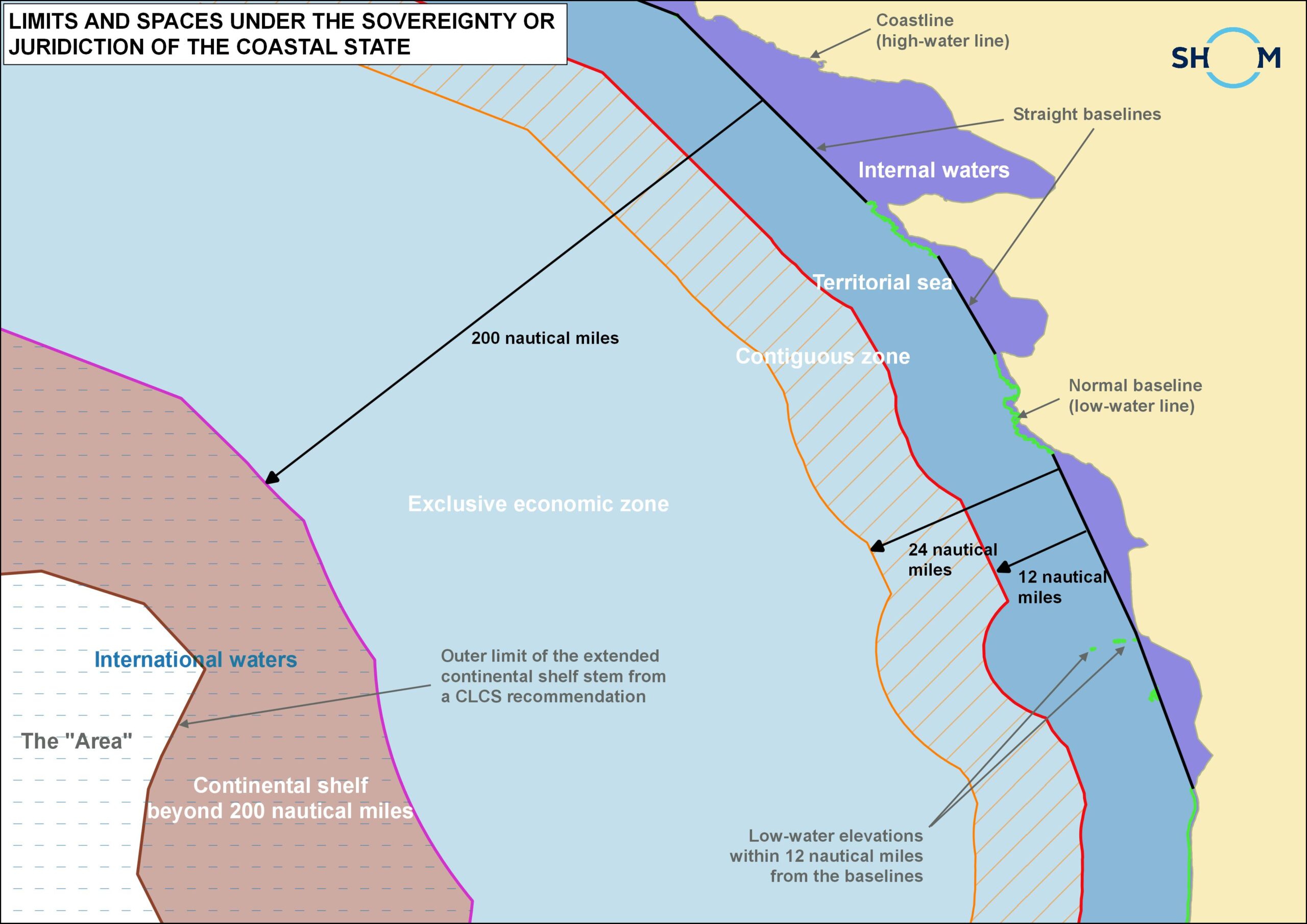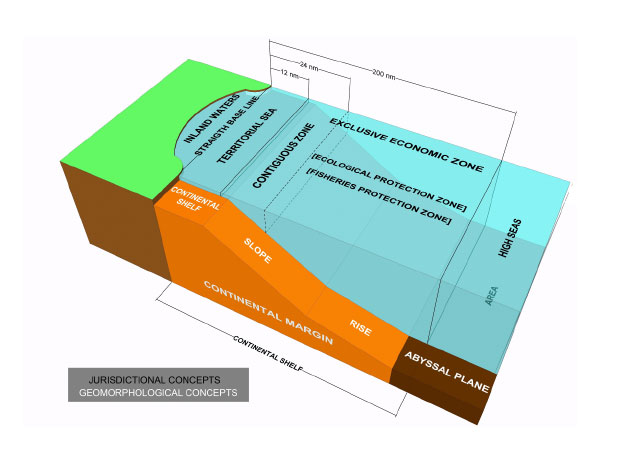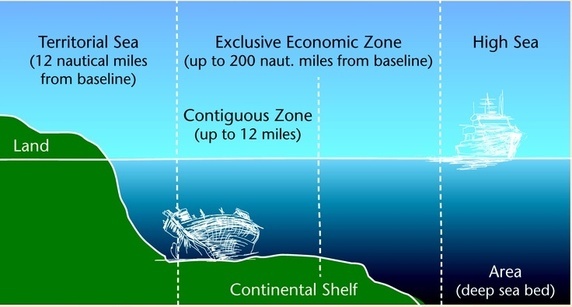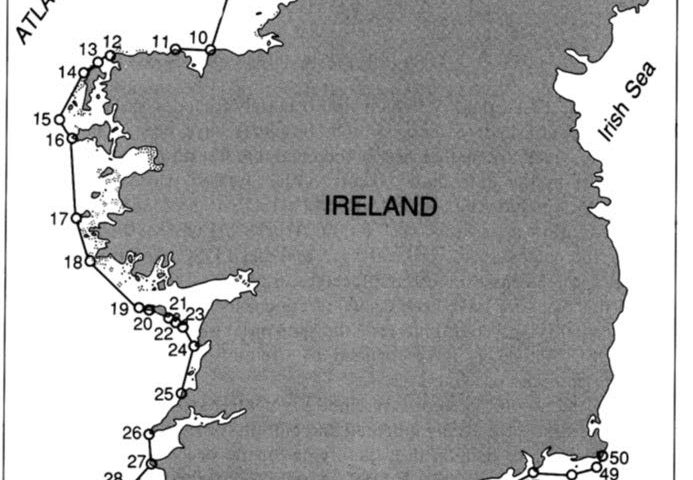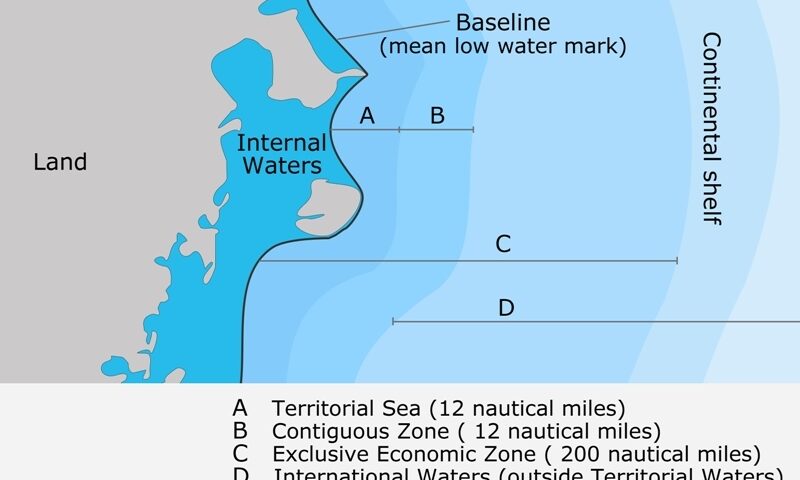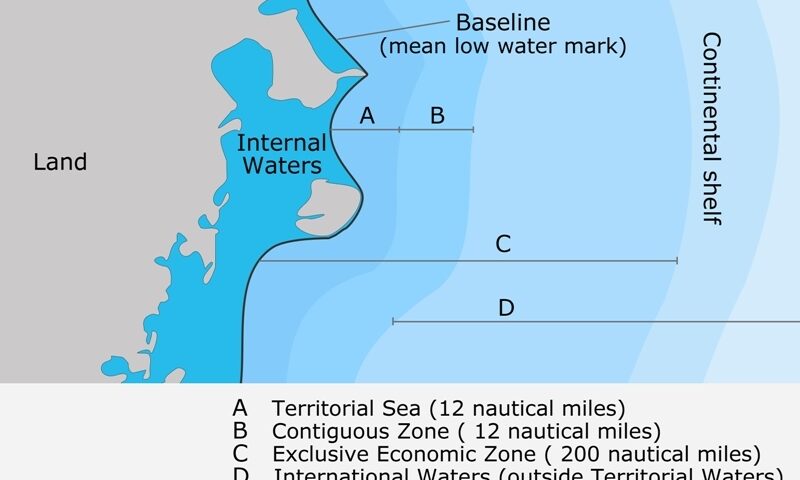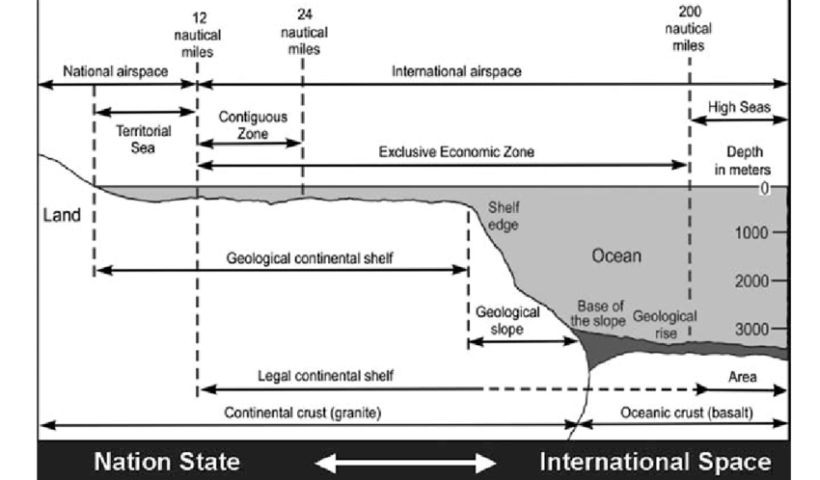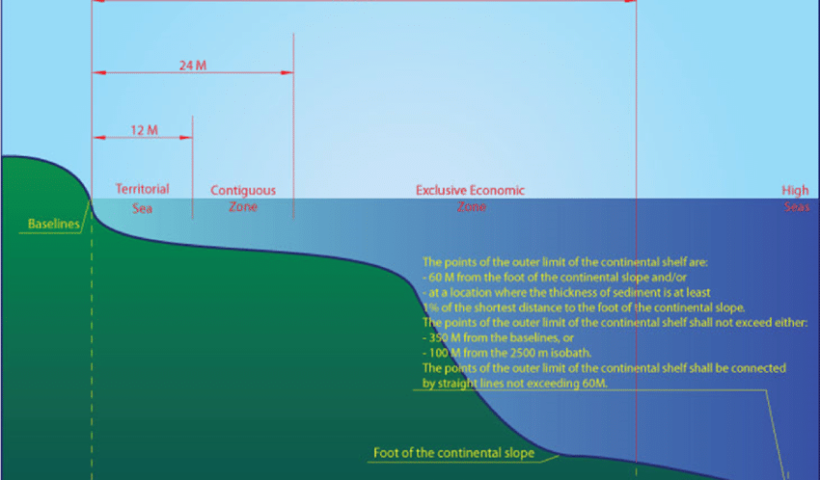Several adjacent coastal States have designated straight territorial sea baselines in a manner that generates overlapping claims to internal waters. The LOSC contains only limited references to internal waters, none of which concern delimitation or OCA management. The absence of detailed provisions in this context flows from the characterization of internal waters under customary law: Such waters appertain to the land territory of a coastal State and are subject, with limited exception, to full territorial sovereignty. The absence in the law of the sea of detailed rules concerning internal waters is a deliberate deference to the territorial rights of coastal States.
View More Overlapping claims to internal waters in law of the sea and LOSCTag: internal waters
RIGHTS AND RESPONSIBILITIES IN MARITIME ZONES
Coastal states can claim five key maritime zones. Proceeding seawards from the coast they are internal waters, territorial seas, the contiguous zone, the exclusive economic zone (or, in some cases, an exclusive fishing zone) and the continental shelf. Archipelagic states may also claim archipelagic waters within their archipelagic baselines. Beyond these national zones of jurisdiction lie the international maritime zones of the high seas and the Area.
The rights of the coastal state and aliens vary in these maritime zones, and do so both spatially and functionally. Thus, the coastal state has more rights closer to shore, for example in internal waters and the territorial sea. Aliens retain considerable rights within a coastal state’s claimed maritime zones concerned with communication issues such as navigation, overflight and the laying of submarine cables and pipelines. The coastal state, in contrast, boasts significant resource related rights, particularly concerning fishing and mineral extraction from the seabed.
what is the deference between national and international maritime zones?
The rights coastal states have in certain maritime zones, notably internal waters, the territorial sea and contiguous zone, affords them security in the face of threats such as smuggling, illegal immigration, other forms of cross-border crime and, ultimately, from the threat of terrorism and the use of military force. The national maritime zones outlined in the UN Convention also offer profound benefits to coastal states in respect of resources, both living resources such as fisheries and non-living resources such as oil and gas. Furthermore, the rights and responsibilities relating to national maritime zones as laid down in the 1982 Convention provide coastal states with opportunities and obligations in the sphere of ocean management. This includes, but is not limited to, navigation, fisheries protection, conservation of living resources, pollution control, search and rescue and marine scientific research.
View More what is the deference between national and international maritime zones?STATE CLAIMS IN VIOLATION OF ARTICLE 4 (LOSC ARTICLE 7), Italy case
STATE CLAIMS IN VIOLATION OF ARTICLE 4 (LOSC ARTICLE 7), Italy case, Gulf of Taranto, internal waters, italy, juridical bay, Juridical Bays, Ligurian Sea, straight baseline
View More STATE CLAIMS IN VIOLATION OF ARTICLE 4 (LOSC ARTICLE 7), Italy caseSTATE CLAIMS IN SUBSTANTIAL CONFORMITY WITH ARTICLE 4 (LOSC ARTICLE 7), lreland case
STATE CLAIMS IN SUBSTANTIAL CONFORMITY WITH ARTICLE 4 (LOSC ARTICLE 7), lreland case, internal waters, lreland, straight baseline
View More STATE CLAIMS IN SUBSTANTIAL CONFORMITY WITH ARTICLE 4 (LOSC ARTICLE 7), lreland caseLegal Nature of Maritime Delimitation in law of the sea and customary international law
Maritime delimitation may be defined as the process of establishing lines separating the spatial ambit of coastal State jurisdiction over maritime space where the legal title overlaps with that of another State. This definition calls for five comments:… Legal Nature of Maritime Delimitation in law of the sea and customary international law, a just and equitable share, continental shelf, délimitation constitutive, délimitation déclarative, EEZ, geographical co-ordinates, Gulf of Maine case, internal waters, International Sea-Bed Authority, maritime delimitation, North Sea Continental Shelf cases, provisional delimitation line, territorial sea, What are the stages of maritime boundary?, What is a single maritime boundary?, What is delimited boundary?, What is maritime space?, What is median line principle?, What is the difference between demarcation and delimitation?, Which law delimits world seas?
View More Legal Nature of Maritime Delimitation in law of the sea and customary international lawInternational Law in the South China Sea
International Law in the South China Sea, artificial islands, Commission on the Limits of the Continental Shelf, contiguous zone, continental shelf, Convention on the Continental Shelf, Convention on the High Seas, Convention on the Territorial Sea, EEZ, exclusive economic zone, internal waters, ISLANDS, low-tide elevations, maritime zones, rocks, south china sea, South China Sea dispute, UNCLOS I, UNCLOS II, UNCLOS III
View More International Law in the South China SeaAccess to Ports in the international law of the sea(internal water)
Access to Ports in the international law of the sea(internal water), 1923 Geneva Convention and Statute on the International Regime of Maritime Ports, Access to Ports, internal waters, Nicaragua case
View More Access to Ports in the international law of the sea(internal water)what is the meaning of INTERNAL WATERS in law of the sea and cases?
Internal waters are ‘those waters which lie landward of the baseline from which the territorial sea is measured’. Specifically, internal waters in a legal sense embrace (i) parts of the sea along the coast down to the low-water mark, (ii) ports and harbours, (iii) estuaries, (iv) landward waters from the closing line of bays, and (v) waters enclosed by straight baselines. On the other hand, as noted earlier, internal waters in the law of the sea do not include waters within the land territory and land-locked waters or lakes. what is the meaning of INTERNAL WATERS in law of the sea and cases?, archipelagic waters vs internal waters, definition of internal waters, estuaries, example of internal waters, harbours, High seas, internal waters, internal waters distance, internal waters examples, internal waters unclos, International waters, landward waters, law of the sea, Mare liberum, ports, territorial sea, trans-boundary waters, waters enclosed by straight baselines, What do you mean about internal waters?, What does internal waters mean?, What is included in the internal waters?, Where are international waters?
View More what is the meaning of INTERNAL WATERS in law of the sea and cases?Baselines and Related Issues on the International law of the sea
The seaward limits of each jurisdictional zone are measured from baselines. Thus rules concerning baselines are of particular importance in the law. In particular, rules governing straight baselines and bays merit serious consideration. Furthermore, attention must be devoted to the legal status of islands and low-tide elevations because the existence of these maritime features may affect the seaward limits of marine spaces under national jurisdiction. (i) What are the rules governing baselines?
(ii) What are the problems associated with rules with regard to straight baselines?
(iii) What are the rules governing juridical bays in international law?
(iv) What is a historic bay and what are the elements of title to such a bay?
(v) What is the definition of an island?
(vi) What are the differences between islands, rocks and low-tide elevations? Baselines and Related Issues on the International law of the sea, baselines, coastal State, internal waters,International law of the sea, jurisdictional zones
Typology of Marine Spaces
In summary, spatial jurisdiction comprises both complete spatial jurisdiction (= territorial sovereignty) and limited spatial jurisdiction (= sovereign rights). In either case, it must be stressed that coastal State jurisdiction over marine spaces is spatial by nature. It follows from the above discussion that marine spaces in the law of the sea can be categorised as follows :
(i) Marine spaces under national jurisdiction
(a) Marine spaces under territorial sovereignty (or complete spatial jurisdiction): internal waters, the territorial sea, international straits, and archipelagic waters.
(b) Marine spaces under sovereign rights (or limited spatial jurisdiction): the contiguous zone (where the EEZ is established), the EEZ and the continental shelf.
(ii) Marine spaces beyond national jurisdiction the high seas and the Area., Typology of Marine Spaces, archipelagic waters, beyond national jurisdiction, contiguous zone, High seas, internal waters, international straits, jurisdictional zones, national jurisdiction, territorial seas, Typology of Marine Spaces
MARITIME ZONE AND JURISDICTION
MARITIME ZONE AND JURISDICTION, contiguous zone, continental shelf, Exclusive Economic Zone (EEZ), High Seas and Deep Ocean Floor, internal waters, law of the sea, Maritime Claims, maritime zone, Maritime Zones and How They Are Determined, River Mouths, territorial sea
View More MARITIME ZONE AND JURISDICTION
